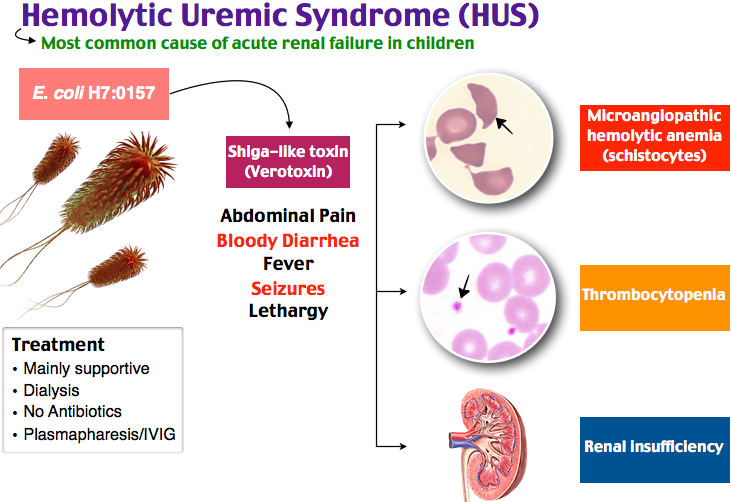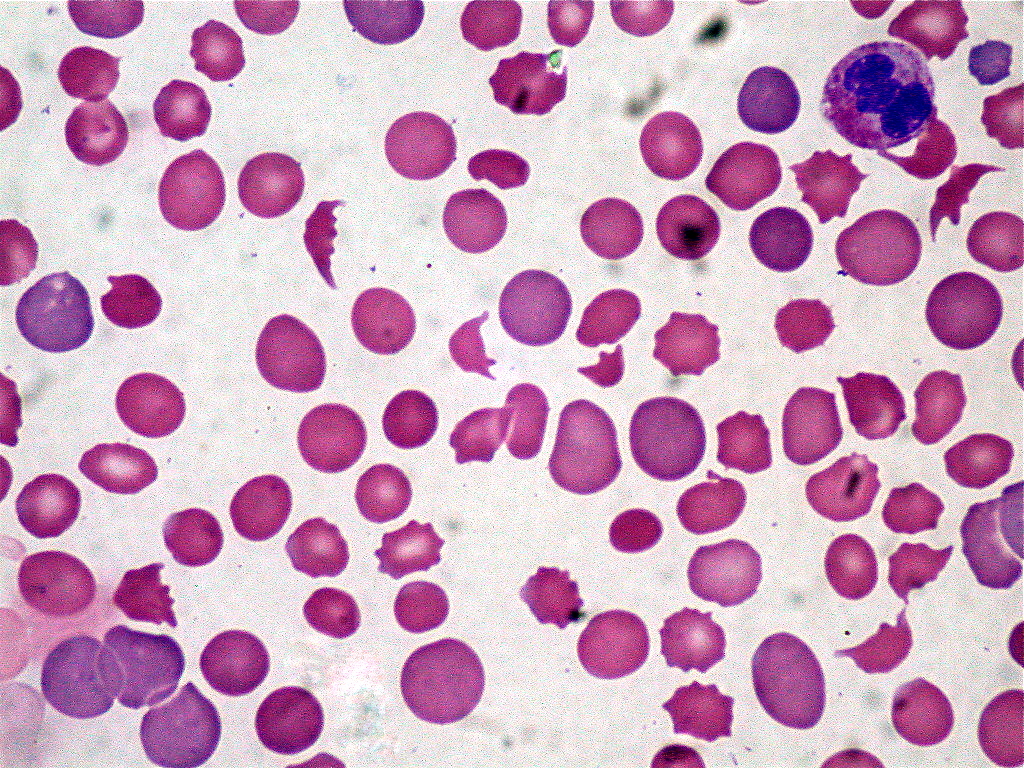Page Contents
OVERVIEW
This page is dedicated to organizing various examples of standardized exam questions whose answer is hemolytic uremic syndrome (HUS). While this may seem a odd practice, it is useful to see multiple examples of how HUS will be characterized on standardized exams (namely the boards and the shelf exams). This page is not meant to be used as a tradition question bank (as all of the answers will be the same), however seeing the classic “test” characterization for a disease is quite valuable.

KEY CHARACTERISTICS OF THIS CONDITION (ON EXAMS)
When it comes to standardized exams, each topic has its own “code” marked by key buzzwords, lab findings, clues, etc. If you are well versed in this code you will be able to more quickly identify the condition that is being discussed, and get the right answer on the exam you are taking. Below is the “code” for HUS.
Chief Complaints:
- Bloody diarrhea may be the presenting complaint (see below regarding suspected E. coli infection)
- Bloody/ red urine can be the chief complaint
- Low urine output: may be another initial complaint (caused by acute kidney injury)
Patient History:
- Recent/past infection with E. coli: Recent history of diarrhea (often bloody) will be the tip off
Clinical Workup:
- Petichiae/purpura can be seen on the physical exam
- Anemia will be detected on the CBC
- Thrombocytopenia on a CBC
- Elevated creatinine: due to acute kidney injury
- Schistocytes on blood smear
- Stool specimen with E. coli: O157:H7 most common strain
QUESTION EXAMPLES
Question # 1
A 7 year old girl si brought to the emergency deparmtne because she has been having bloody diarrhea for the past week. She has also been complaining of generalized fatigue for the past 2 days. Her temperature is 98.5°F, pulse is 110/min, respirations are 15/min, and her blood pressure is 105/60 mm Hg. Physical exam shows the presecen of pallor as well as scleral icterus. The liver is not enlarged or tender. Laboratory studies are collected and shown below:
- Hemoglobin: 6.1 g/dL ***
- Mean corpuscular volume: 80µm³
- Leukocyte count: 17,000/mm³
- Reticulocyte count: 13%
- Platelet count: 50,100/mm³ ***
What is the most likely diagnosis?
Explanation # 1
Recently history of bloody diarrhea (possible E.coli infection) + anemia + low platelets = HUS
Question # 2
A 5 year old girl is brought to the clinic because of decreased energy, bloody diarrhea, and “spots” that cover her arms and legs. The patient’s mother has noticed all of this over the past 2 days. The patients immunizations are up to date, she has no notable past medical history, and there is no record of any allergies. The patient has had no fever, vomiting, or signs of joint pain. The patient’s mother denies any recent travel or exposure to animals. In the clinic the little girl’s temperature is 98.9°F and a physical examination demonstrates a child that is lethargic and weak. The child’s face and extremities are swollen. She has scattered petechiae and a few purpura on her arms. There is a generalized abdominal tenderness. Labs are collected and the results are below:
Serum:
- Hemoglobin: 6.2 g/dL ***
- Platelets: 40,000/µL ***
- Creatine: 2.4 mg/dL ***
- Total bilirubin: 3.1 mg/dL ***
- Direct bilirubin: 0.3 mg/dL ***
Urine:
- Specific gravity: 1.024
- pH: 5
- Protein: +2 ***
- Blood: moderate ***
- Leukocyte esterase: negative
- Bacteria: none
- White blood cells: 50+/hpf ***
- Red blood cells: 20-30/hpf ***
- Casts: hyaline casts ***
What is the most likely diagnosis in this patient?
Explanation # 2
Recently history of bloody diarrhea (possible E.coli infection) + petechiae/purpura + anemia + low platelets + increased indirect bilirubin + elevated creatine (acute renal failure) + protein/blood/WBC/casts in urine = HUS
Question # 3
A 8 year old boy is brought to the emergency department due to abdominal pain and fatigue. He developed the abodminla pain about a week ago, and has also been experiencing both vomiting and diarrhea as well. He had noticed significant stool in his diarrhea about 4 days ago, however this has resolved. His mother taught he was improving until he developed more diffuse abodminla pain today, and was very unwilling to get out of bed. The patient has been drinking normal amounts, however has not urinated for the past 26 hours. Many other family members also suffered from nausea and diarrhea this past week after they all attended the same family cookout last week, however this patient is the only one who still has not fully recovered. A physical exam reveals scleral icterus, diffuse abdominal tenderness, and 2+ pitting edema. What diagnosis could explain this patient’s presentation?
Explanation # 3
Past history bloody diarrhea + suspected E.coli infection (family cookout) + scleral icterus (jaundice from hemolysis) = HUS
Question # 4
A 5 year old female child is brought to the ER because she has developed colicky abodminla pain, vomiting, and also loose bloody stools. She was treated with supportive care and later started to recover. A few days after this, her parents bring her back to the ER because she has only urinated once in the pat day, and during this episode her urine was red in color. The patient’s physical exam is within normal limits, with the exception of conjunctival pallor. Labs are collected and shown below:
- Hemoglobin: 7.5 g/dL ***
- Platelets: 75,000/mm³ ***
- Creatinine: 1.9 mg/dL ***
Urinanlsysi reveals the presence of proteinuria and hematuria. What is the likely diagnosis in this patient?
Explanation # 4
Recently history of bloody diarrhea (possible E.coli infection) + anemia + low platelets + elevated creatine = HUS
Question # 5
A 4 year old male is brought to the hospital because he has been producing low volumes of dark urine for the past couple of days, and has been very fatigued. His parents explain act the child was experiencing abodminla pain, fever, and bloody diarrhea about a week ago that resolved on its own without treatment. This all happened the day after the family came back from their friends lakehouse where they swam, had a cookout, and went hiking. A physical exam is notable only for pallor. Lab studies reveal the presence of anemia, thrombocytopenia, and an elevated serum creatinine/BUN. What is the likely diagnosis in this patient?
Explanation # 5
Recently history of bloody diarrhea (possible E.coli infection from cookout) + anemia + low platelets + elevated creatine = HUS
Question # 6
A 6 year old male is brought to the hospital because he is lethargic and oliguric. He recently developed diarrhea earlier in the week and was having frankly bloody stools. Lab studies are conducted and reveal increased levels of BUN and creatinine in the serum. A blood smear shows the presence of fragmented erythrocytes. What is the likely diagnosis in this patient?
Explanation # 6
Low urine output + recently history of bloody diarrhea (possible E.coli infection from cookout) + elevated creatine + schistocytes = HUS
Question # 7
A 6 year old male comes to the clinic for a follow up visit. About 1 week ago he began to have many episodes of bloody diarrhea. These have since resolved. Currently lab studies show evidence for acute renal failure. Anemia and thrombocytopenia are detected on the CBC. Coagulation studies are unremarkable. A peripheral blood smear is shown below:

What is the likely diagnosis in this patient?
Explanation # 7
Recently history of bloody diarrhea (possible E.coli infection from cookout)+ renal failure (elevated creatine) + anemia + low platelets + schistocytes on blood smear = HUS
Question # 8
A 5 year old male has a fever and acute renal failure. A stool specimen grows out the O157:H7 strain of E. coli. What is the likely diagnosis in this patient?
Explanation # 8
Acute renal failure + E. coli infection (O157:H7) = HUS
TESTABLE FACTS ABOUT THIS TOPIC (BEYOND ITS IDENTIFICATION)
Many questions on standardized exams go beyond simply recognizing the underlying topic. Often there are specific testable facts regarding some aspect of the topic’s pathophysiology/management/clinical implications that are commonly asked. Some of these are listed below:
Cause:
- Shiga toxin producing bacteria:
- Escherichia coli O157:H7
- Shigella
- Undercooked meat is a common way patients become infected
Page Updated: 11.08.2016